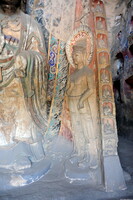Yungang Grottoes: Cave 11
unknown (Chinese)

Download1A2-CH-D-YG-11-A19_cp.jpg (504.7Kb)
Alternative Title
云冈石窟
Date
471-494Description
Pagoda pillar with standing Buddha facing the entry to the cave, detail with bodhisattva on right side; The Yungang Grottoes are located 16 km west of Datong and comprise about 53 caves and 51,000 statues. The site stretches about 1 kilometer from east to west and was hollowed from the sandstone cliffs of the Wuzhou Mountains during the 5th century CE under the patronage of the Northern Wei dynasty. Founded by the Tuoba or Toba people, who ruled northern China during the Northern and Southern Dynasties period (310-589 CE), the Wei dynasty adopted Buddhism as its state religion. Work was begun at Yungang by the emperor Wenchengdi (reigned 452-465). The caves range in width from 23 m to a few metres. In 494, the Wei moved their capital from Datong to Luoyang and the Yungang Grottoes slowly fell into decay. The Grottoes have been a UNESCO World Heritage site since 2001. Caves 7-12, which seem to be grouped in pairs, show a more regular plan than the Tanyao Caves. Rectangular, they are divided into front and rear chapels. The main image is accompanied by representations of bodhisattvas, triads of the Buddha, flying apsarasas (heavenly beings), heavenly musicians, jātakas (stories from the life of the historical Buddha) and ornamental reliefs covering the walls, ceilings and entrance. Cave 11 has a large central pagoda pillar that stretches to the ceiling, carved on four sides with the Buddha. Cave 11 has decorations with a specific date of 483, in honor of the imperial family. Source: Grove Art Online; http://www.oxfordartonline.com/ (accessed 5/9/2011)
Type of Work
relief (sculpture); sculpture (visual work); shrine (structure)Subject
architecture, decorative arts, deities, Buddhism and art--China, Silk Road, Buddhist cave art, Chinese, Northern Wei
Rights
Rights Statement
Licensed for educational and research use by the MIT community only